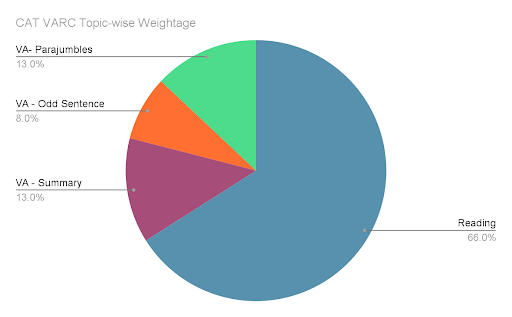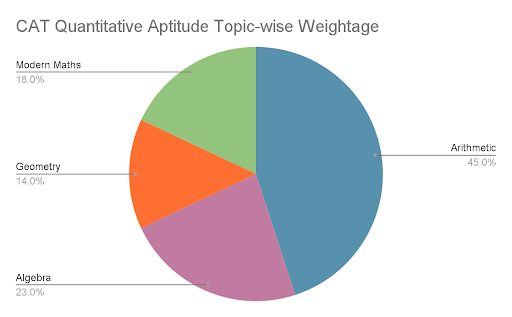


Introduction of CAT exam syllabus 2024
CAT exam syllabus 2024 is a complete guide for every MBA aspirant who wants to crack the Common Admission Test (CAT). CAT is the golden ticket to the top B-schools in India, including IIMs and tests you on Verbal Ability (VARC), Data Interpretation & Logical Reasoning (DILR) and Quantitative Ability (QA). Every area is a test of your ability, head and troubleshooting skills!
Are you planning to crack the CAT exam 2024? The first step is to be thorough about the syllabus. Knowing the topics gives you confidence and allows you to create a specific strategy for preparation.
We cover everything here from section-wise syllabus with preparation tips to important CAT exam dates and FAQs so that you can be fully equipped.
Interesting Fact: More than 2 lakh students take the CAT every year. Want to be the performing at the top? Explore the details, and begin your journey today!
Why Understanding the CAT Exam Syllabus is Crucial
This is not just a syllabus; the CAT exam syllabus is the blueprint of your preparation and an outline of your MBA aspirations. Being aware of all syllabus, you can learn about the relevant areas, your strengths and weaknesses, and plan a strategy accordingly. Having a clear idea of the syllabus makes sure that you spend your time on something other than studying less essential topics and you concentrate on high-yield topics instead.
Interestingly, there is no particular and rigid syllabus for the CAT. Trend analysis of the last many years helps one know the topics most frequently tested on Verbal Ability (VARC), Data Interpretation and Logical Reasoning (DILR), and Quantitative Ability (QA). Understanding the weightage and structure of every section also plays a vital role in scheduling your time well.
CAT Exam Syllabus 2024: Section-Wise Breakdown

There are three sections in the CAT exam:
- Verbal Ability and Reading Comprehension VARC
- Data Interpretation and Logical Reasoning DILR
- Quantitative Ability (QA)
Each section would test particular skills that are required in management studies.
1.CAT Exam Syllabus VARC Section
Reading Comprehension (RC)
Passage Types: Passages can be literature, social science, business, science, or humanities based. Questions will test your understanding, ability to infer, and analyze the content.
Question Types:
- Main idea or central theme of the passage.
- Inference-based questions.
- Tone or style of the passage.
- Vocabulary and context-based questions.
- Author’s point of view or purpose.
Grammar and Sentence Correction
Sentence Correction: Error spotting in sentence construction, subject-verb agreement, use of tenses, prepositions, conjunctions, articles, and modifiers.
Types of Errors:
- Wrong usage of punctuations.
- Incorrect word forms with examples: noun versus verb.
- Redundancy or wordiness in sentences.
- Sentence Completion: Selecting the appropriate word or phrase to logically and grammatically complete a sentence.

Para Jumbles (Rearranging Sentences)
Rearrange a set of sentences to form a cohesive paragraph.
Keys to understanding the flow of ideas, linking words, and sentence structure.
Identify the introduction and conclusion sentences.
Vocabulary
- Synonyms & Antonyms: Identify words that are synonyms or antonyms.
- Contextual Vocabulary: Determine a word’s meaning by looking at its use in the passage.
- Word Usage: Identify nuance differences in word meanings based on context.
2.CAT Exam Syllabus DILR Section
Data Interpretation (DI)
Types of Data:
- Tables (such as frequency tables, percentage distribution).
- Graphs: Bar, Line, Pie, Mixed Graphs.
- Caselets: Interpretation of data in the form of short paragraphs.
Types of Questions:
- Interpretation of trends or data relationships.
- Calculation-based questions, such as percentages, averages.
- Data sufficiency: If the data in the question is sufficient to answer the question.
Logical Reasoning (LR)
- Puzzle-Type Questions: Seating order, floor puzzles, distribution puzzles (who sits where or who possesses what).
- Blood Relationships: Questions involving family trees, relationships, and hierarchies.
- Venn Diagrams: Logical relationships between different groups of things (e.g., people who like different colors).
- Syllogisms: Deduction using statements such as “All cats are animals; some cats are black.”
- Series & Sequences: Identifying patterns in a number or letter sequence.
- Other Topics: Binary Logic, Clock and Calendar Problems, Direction Sense, etc.
3. CAT Exam Syllabus QA Section
Arithmetic
- Basic Concepts: Percentages, Profit & Loss, Simple and Compound Interest, Time, Speed, Distance, Time & Work, Averages, and Ratios.
- Application-Based Problems: Work and time efficiency problems, investment and returns, mixture and allegation problems, etc.
- Speed and Distance: Relative speed, trains, boats, and streams.
Algebra
- Equations: The solution of linear and quadratic equations, systems of equations.
- Inequalities: Determining the solution of inequalities and range of values for variables.
- Functions and Graphs: Understanding properties of functions and their graphical representations.
- Progressions: Arithmetic Progression (AP), Geometric Progression (GP), and Harmonic Progression (HP).
Geometry and Mensuration
- Geometry Basics: Lines, angles, circles, triangles and polygons.
- Properties of Triangles: Area, perimeter, and special triangles – isosceles, equilateral, right-angle.
- Mensuration: Volume and surface area of solids – cylinder, cone, sphere, cube and cuboid.
- Coordinate Geometry: Distance formula, slope of a line, equation of a line, and area of triangles.
Number System
- Divisibility: Divisibility rules, LCM, HCF, prime numbers.
- Base System: Conversion between different number bases (binary, decimal, hexadecimal).
- Properties of Numbers: Odd/even, prime/composite numbers, factors and multiples.
- Remainder Theorem: Finding remainders for divisions and solving modular arithmetic problems.
Modern Math
- Permutations and Combinations: Counting methods, arrangement, selection, and probability.
- Probability: Basic concepts of probability, permutations, and combinations-based probability problems.
- Set Theory: Union, intersection, Venn diagrams, and operations on sets.

How to Prepare for CAT Exam Syllabus 2024
The CAT exam syllabus preparation needs a blend of strategy, time management and consistency. Here’s a step-by-step guide:
- Syllabus: First, go through each section and topic to set the priority list for your preparation.
- Prepare a Study Schedule: Devote specific time to every part so stick with your schedule.
- Taking Mock Tests Regularly: Attempt the exam in a similar atmosphere as that of an actual examination and this would help you manage your time better and help you pinpoint weak sections.
- Strengthen Your Weak Areas: Dedicate more time to concepts you are struggling with and/or weak at, as this will help improve your overall preparation.
- Keep Revising: A revision at periodic intervals helps you remember whatever you studied.
- Solve Previous Year Questions: Get hands-on experience with past papers to recognize trends and commonly tested topics.
CAT Exam Date 2024: What You Need to Know
The CAT exam date for 2024 is yet to be officially announced. However, the CAT exam is usually conducted on the last Sunday of November. Working off this trend, that puts the timeline to expect as such:
- Notification Release: July 2024
- Application Window: August to September 2024
- Admit Card Availability: October 2024
- CAT Exam Date: November 24, 2024
The official CAT exam website has all the necessary updates regarding exam dates, registration dates, and other notifications.
The CAT is one of the most competitive exams in India, with around 2 lakh aspirants vying for just under 5,000 IIM seats every year. Knowing the timeline is critical to preparing successfully. Save the dates so that you don’t miss any important deadlines!
Conclusion
CAT exam syllabus 2024 helps you channel your preparation for one of the most desired management entrance examinations across India. The syllabus is split into three sections, which are Verbal Ability and Reading Comprehension (VARC), Data Interpretation and Logical Reasoning (DILR & QA), which ensures the ability to analyze, problem-solve, and verbal skills are tested. And success in all those areas DILR (solving complex puzzles), QA (difficult concepts of maths) and VARC(Reading Comprehension and grammar needs an understanding of these topics well before time).
Take your preparation a notch higher and get confident with mock tests, previous years’ papers, and books suggested by experts.
Tip: The CAT Exam syllabus is the first step towards securing a good percentile and a seat in any of the best MBA programs.
Are you ready to love the chase, then? Start now and watch your dream MBA come true!
FAQs
Q1. What topics are covered in the syllabus of CAT exam?
Ans. CAT exam syllabus includes three major sections.
VARC (Verbal Ability and Reading Comprehension) —The section tests your English skills and confronts you with reading comprehension, para jumbles, errors in sentence grammar, vocabulary, etc. It includes reading comprehension (RC), grammar, vocabulary, sentence correction, and passage summary.
DILR (Data Interpretation and Logical Reasoning) – This section is meant to test your analytical skills wherein you have to interpret data from charts (Bar Graphs, Pie Charts, Line Graphs) as well as logical puzzles, caselets, and muddled arrangements, making it the solving seat arrangements, and blood relation issues.
Quantitative Ability (QA): Quantitative Ability starts with quantification ability or math section of the test. Some of the most important topics are arithmetic that includes percentages, profit & loss, algebra that involves linear and quadratic equations, geometry that includes triangles, circles, and mensuration and Modern Maths that deals with probability, permutations & combinations.
Q2. Is there any change in the syllabus of CAT 2024 exam?
Ans. No Changes in the CAT Syllabus 2024 as of now Despite not having changed for years, do check for changes on the CAT official website. Hence, if and when not uniform, it is always easy to predict at times, but given the whole training period/ curriculum has a known outline already defined beforehand, this proves difficult for all conditioned minds, so such requires or demands utmost joint effort along with relatively accurate scheming-based practice.
Q3. How tough is the CAT exam syllabus?
Ans. The CAT is a tough test, but it is conquerable. The challenge is the time limit and diversity of question types that not only check your accuracy but speed as well. A good knowledge of the CAT exam syllabus, consistent practice, and plan can get you high percentile. The challenges are really overcome by mock tests, time management, and focusing where we fail.
Q4. How much time will it take to prepare for the CAT Exam syllabus?
Ans. It takes 6-9 months of dedicated preparation for most aspirants to complete the entire CAT exam syllabus. Taking the exam at an earlier point lets you distribute your time across all three parts and take many practice tests. Preparation in advance also points out weak areas where you will need to work hard to pass rates, thereby providing more time for getting your game plan together.
Q5. Are there books that specifically focus on the CAT exam syllabus?
Ans. Yes, many books can be used to complete the syllabus:
- Quantitative Aptitude by Arun Sharma: A comprehensive ultimate book for QA basics and advanced questions practice.
- Nishit Sinha—His book on Verbal Ability and Reading Comprehension is go-to choice for all topics in VARC; besides it, RC has many exercises, grammar, and vocabulary.
- Logical Reasoning and Data Interpretation for the CAT by Nishit Sinha: Ideal for logical puzzles, graphs or data interpretation
Along with mock tests and online practice tools, these sources will guarantee you complete preparation.




